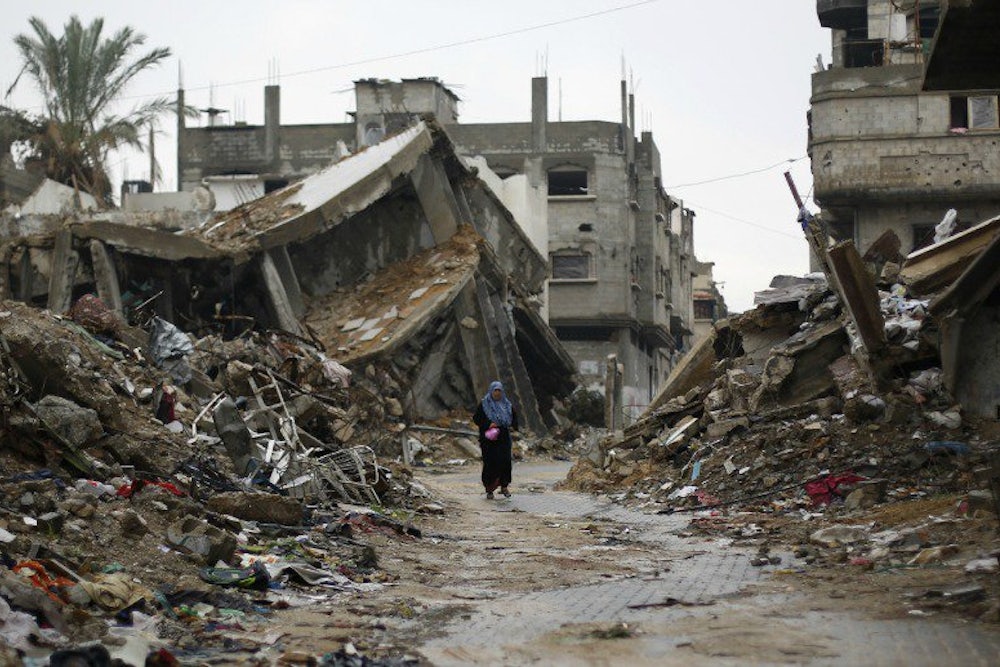At the end of last August, by the end of Israel’s Operation Protective Edge, airstrikes and ground warfare had destroyed some 16,000 homes in Gaza and damaged more than 100,000. These numbers do not include the thousands of homes never repaired from previous Israeli operations in the tiny coastal territory, currently home to more than 1.8 million Palestinians. When he visited last October, U.N. Secretary-General Ban Ki-moon said the destruction from the war—in which 2,100 Gazans, mostly civilians, were killed—was “beyond description.” He added that it was worse than what he had seen after Operation Cast Lead (2008-2009), the first major conflict in Gaza since Hamas was elected in 2006.
On Thursday, the anti-poverty group Oxfam International wrote in a press release that, at the current rate, rebuilding of Gaza’s housing, education, and health infrastructure "could take more than 100 years to complete." The delay, as Oxfam notes, is due to the Israeli blockade, which is now in its eighth year; it is preventing the essential building materials from entering the strip. While 800,000 truckloads of construction material are needed, only 1,661 have been allowed in since October’s international conference in Cairo in which donors pledged $5.4 billion to rebuild Gaza.
So far, as Chris Gunness of the U.N. Relief and Works Agency (UNRWA) wrote last week in The Guardian, donors have not delivered on those financial promises. Catherine Essoyan, Oxfam's Regional Director, said in the group’s statement that it is “utterly deplorable that the international community is once again failing the people of Gaza when they need it most." Aside from the lack of funds, the primary challenge to the aid and reconstruction of Gaza is the Israeli blockade. “Only an end to the blockade of Gaza will ensure that people can rebuild their lives,” Essoyan said.
The Israeli government has argued that they are restricting shipments of construction materials due to their “dual-use” nature, meaning that concrete, bricks, and steel reinforcing could also be used for military purposes. It points to Hamas’s tunnels into Israeli territory, used to attack military targets during the last conflict and contributing to the death of more than 60 IDF soldiers. To appease Israeli concerns, the U.N. brokered a deal: They created a monitoring mechanism to ensure that construction materials would be used for civilian purposes.
That agreement came under fire from some international NGOs and officials. “It is entirely based on Israeli discretion and goodwill,” one source that saw the deal’s text told The Guardian in October. The same report also noted that a U.N. risk assessment plan of the monitoring scheme found that the “likelihood of Israel reneging on agreements as ‘high risk’ and potentially ‘catastrophic.’” Nonetheless, many saw the deal as a positive step forward.
Several months after the signing of the agreement, Oxfam’s report shows that the U.N.’s mechanism has so far failed. The Israeli blockade is still crippling Gaza.
The region has often been called the world’s largest open-air prison, though in some ways it is worse. This is evidenced by the young and desperate Gazans hopping fences to sneak into Israel—despite knowing they will likely be put in prison. A recent report in The New York Times examined the phenomenon, noting that 84 Palestinians attempted to enter Israel between September and January. “Compared with Gaza, ‘the prison in Israel is like a five-star hotel,’ said Youssef Abbas, 21, who did stints there after crossing the border in 2010 and 2008,” the Times wrote.
The unemployment rate in Gaza is nearly 50 percent. According to Oxfam, exports are 2.7 percent of the pre-blockade levels. Most residents experience blackouts 18 hours a day. Up to 95 percent of the water is undrinkable. The Israeli navy fired at fishermen, whose livelihoods they have destroyed with a six nautical mile limit, at least every day from December to February.
The conditions in Gaza are such that the existence and strength of extremist groups are all but inevitable. If the blockade continues, and the current rates of rebuilding remain unchanged, those conditions—and thus the conflict—will continue for decades to come.
